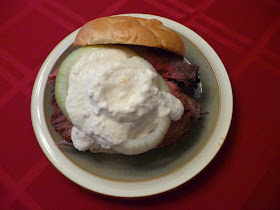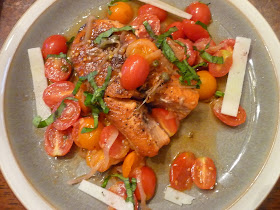Culinarily speaking, New Mexico is perhaps known best for its chiles. The most prominent pepper is the Hatch chile, which gets its name from the fact that the chile grows in the area around Hatch, New Mexico. Despite its prominence, the Hatch chile is not the only one grown and cultivated in New Mexico.
During my trips to Santa Fe, I discovered a heirloom chile known as the Nambé chile (capsicum annuum longe ground Nambé supreme). Like the Hatch Chile, the Nambé chile gets its name from the area in which it is cultivated, namely, the Nambé Pueblo in northeastern New Mexico. The Nambé chile has a very earthy flavor, as well as a very spicy kick.
Recently, I decided to make that heirloom chile the centerpiece of a wing recipe. I also used the traditional accompaniment of spices -- paprika, onion powder, garlic powder -- to round out the recipe, plus a little cumin to add some depth to the rub. I could have added other spices, such as thyme or oregano, but, I left that for the next time I made this recipe.
During my trips to Santa Fe, I discovered a heirloom chile known as the Nambé chile (capsicum annuum longe ground Nambé supreme). Like the Hatch Chile, the Nambé chile gets its name from the area in which it is cultivated, namely, the Nambé Pueblo in northeastern New Mexico. The Nambé chile has a very earthy flavor, as well as a very spicy kick.
Recently, I decided to make that heirloom chile the centerpiece of a wing recipe. I also used the traditional accompaniment of spices -- paprika, onion powder, garlic powder -- to round out the recipe, plus a little cumin to add some depth to the rub. I could have added other spices, such as thyme or oregano, but, I left that for the next time I made this recipe.
NAMBE WINGS
A Chef Bolek Original
Serves 1-2
Ingredients:
12 chicken wings, first and second parts, wing tips removed
2 teaspoons of Native Nambé Chile Pepper
1 teaspoon of paprika
1 teaspoon of onion powder
1 teaspoon of garlic powder
1/2 teaspoon of cumin
1/4 teaspoon of salt
Directions:
1. Prepare the rub. Mix the chile pepper, paprika, onion powder, garlic powder, cumin and salt together in a bowl. After rinsing the chicken and patting it dry, rub the spice mix onto the chicken.
2. Cook the chicken. You can either cook the chicken under the broiler for about twenty to twenty-five minutes or bake the wings at 400 degrees Fahrenheit for about thirty minutes.
PAIRING THIS RECIPE
It is a universal truth that beer is the best pairing to buffalo wings or chicken wings. For a spicy rub such as this one, the best beer is probably a lighter, crisper beer, such as a pilsner or a pale ale.
ENJOY!
































